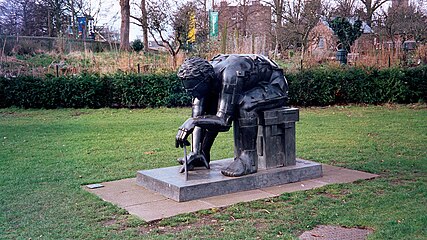
Sir Eduardo Luigi Paolozzi was a Scottish artist, known for his sculpture and graphic works. He is widely considered to be one of the pioneers of pop art.

National Galleries Scotland: Modern is part of National Galleries Scotland, which is based in Edinburgh, Scotland. The Modern houses the collection of modern and contemporary art dating from about 1900 to the present in two buildings, Modern One and Modern Two, that face each other on Belford Road to the west of the city centre.
Events from the year 1951 in art.
Kenneth Laurence Martin, was an English painter and sculptor who, with his wife Mary Martin and Victor Pasmore, was a leading figure in the revival of Constructionism.

Henry Spencer Moore was an English artist. He is best known for his semi-abstract monumental bronze sculptures which are located around the world as public works of art. Moore also produced many drawings, including a series depicting Londoners sheltering from the Blitz during the Second World War, along with other graphic works on paper.

Tate Britain, known from 1897 to 1932 as the National Gallery of British Art and from 1932 to 2000 as the Tate Gallery, is an art museum on Millbank in the City of Westminster in London, England. It is part of the Tate network of galleries in England, with Tate Modern, Tate Liverpool and Tate St Ives. It houses a substantial collection of the art of the United Kingdom since Tudor times, and in particular has large holdings of the works of J. M. W. Turner, who bequeathed all his own collection to the nation. It is one of the largest museums in the country. The museum had 525,144 visitors in 2021, an increase of 34 percent from 2020 but still well below pre- COVID-19 pandemic levels. In 2021 it ranked 50th on the list of most-visited art museums in the world.
Isaac Newton was an English mathematician, natural philosopher, theologian, alchemist and one of the most influential scientists in human history. His Philosophiae Naturalis Principia Mathematica is considered to be one of the most influential books in the history of science, laying the groundwork for most of classical mechanics by describing universal gravitation and the three laws of motion. In mathematics, Newton shares the credit with Gottfried Leibniz for the development of the differential and integral calculus.

Newton is a monotype by the English poet, painter and printmaker William Blake first completed in 1795, but reworked and reprinted in 1805. It is one of the 12 "Large Colour Prints" or "Large Colour Printed Drawings" created between 1795 and 1805, which also include his series of images on the biblical ruler Nebuchadnezzar.

Ralph Brown was an English sculptor who came to national prominence in the late 1950s with his large-scale bronze Meat Porters, commissioned for Harlow New Town, Essex and is known for his sensual, figurative sculptures.
Newton most commonly refers to:

The Artist as Hephaestus is a bronze statue by Sir Eduardo Paolozzi, created in 1987. It depicts a standing human figure, a self-portrait of Paolozzi 2.64 metres tall, with the left foot advanced as if walking, holding two pierced objects akin to sieves.

Robert Ernest Clatworthy RA was a British sculptor and teacher of art. He was head of the fine art department at the Central School of Art and Design in London from 1971 to 1975, and was elected a fellow of the Royal Academy of Arts in 1973.

A bronze statue of Isambard Kingdom Brunel, also known as Brunel Monument or the Isambard Brunel Monument, by Carlo Marochetti, stands on the Victoria Embankment in London, England, at the west end of Temple Place. The statue rests on a Portland stone pedestal, with flanking screens and benches, by the architect Richard Norman Shaw.

Ivor Abrahams was a British sculptor, ceramicist and print maker best known for his polychrome sculptures and his stylised prints of garden scenes. His career long exploration of new subject matter, novel techniques and materials made his art dealer, James Mayor, describe him as Europe's equivalent of Robert Rauschenberg.

Revolving Torsion is a 1972–73 kinetic sculpture and fountain by the Russian-born Constructivist artist Naum Gabo. It was commissioned for the Tate Gallery and has been on long-term loan to the Guy's and St Thomas' Charity for display at St Thomas' Hospital in Lambeth, London, since 1975. It was designated a Grade II*-listed building in January 2016.

Piscator, also known as the Euston Head, is a large abstract sculpture by Eduardo Paolozzi. It was commissioned by British Rail in 1980 for the forecourt of Euston Station in London, and is named for the German theatre director Erwin Piscator.

Horse and Rider is a 1974 bronze equestrian sculpture by Elisabeth Frink. The work was commissioned for a site in Mayfair; another cast is in Winchester. It was described by Frink as "an ageless symbol of man and horse".
Gabrielle Muriel Keiller was a Scottish golfer, art collector, archaeological photographer and heir to Keiller's marmalade in Dundee. She bequested a large collection of Dada and Surrealist art to the Scottish National Gallery of Modern Art.

Locking Piece is a sculpture by Henry Moore. It comprises two interlocking forms holding a third element between them, on a bronze base. It is usually mounted on a separate plinth. The sculpture was created in 1962–1964, and bronze casts were made in 1964–1967.

















